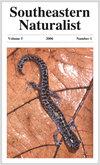A Species Profile for the Black Spiny-Tailed Iguana (Ctenosaura similis)
IF 0.4
4区 环境科学与生态学
Q4 BIODIVERSITY CONSERVATION
引用次数: 0
Abstract
Abstract - Ctenosaura similis (Black Spiny-tailed Iguana) is native to Mexico and Central America, where it is a wide-ranging habitat-generalist that is well adapted to human-altered environments. Black Spiny-tailed Iguana is considered one of the larger, heavier iguanid species, identified by its coloration and a series of enlarged whorls of spiny scales on the tail. Despite harvest rates for human consumption and the pet trade, Black Spiny-tailed Iguana is currently considered a species of least concern in their native range. There have been several introductions outside of their native range, many of which have become established due to their generalist nature. In Florida, Black Spiny-tailed Iguana was first introduced in 1979 and has been reported in 24 counties. Early removal efforts of other introduced iguanids such as Ctenosaura pectinata (Mexican Spiny-tailed Iguana) and Iguana iguana (Green Iguana) could serve as case studies to develop and implement eradication and management plans for this species. We provide a comprehensive summary of natural history findings on Black Spiny-tailed Iguana, including management methods and potential ecological impacts as an invasive species in the southeastern United States.黑刺尾鬣蜥的物种概况
黑刺尾鬣蜥(Ctenosaura similis)原产于墨西哥和中美洲,在那里它是一个广泛的栖息地通才,很好地适应了人类改变的环境。黑刺尾鬣蜥被认为是更大、更重的鬣蜥物种之一,通过它的颜色和尾巴上一系列扩大的刺状鳞片来识别。尽管人类消费和宠物贸易的采收率很高,但黑刺尾鬣蜥目前被认为是其本土范围内最不受关注的物种。在它们的原生范围之外已经有几次引入,其中许多由于它们的通才性质而建立起来。在佛罗里达州,黑刺尾鬣蜥于1979年首次被引入,并在24个县被报道。早期清除其他引进的鬣蜥,如Ctenosaura pectinata(墨西哥刺尾鬣蜥)和Iguana Iguana(绿鬣蜥)可以作为案例研究,以制定和实施该物种的根除和管理计划。本文综述了黑刺尾鬣蜥作为入侵物种在美国东南部的自然历史发现,包括管理方法和潜在的生态影响。
本文章由计算机程序翻译,如有差异,请以英文原文为准。
求助全文
约1分钟内获得全文
求助全文
来源期刊

Southeastern Naturalist
环境科学-生态学
CiteScore
1.20
自引率
16.70%
发文量
31
审稿时长
18-36 weeks
期刊介绍:
The Southeastern Naturalist covers all aspects of the natural history sciences of terrestrial, freshwater, and marine organisms and the environments of the southeastern portion of North America, roughly bounded from North Carolina south to Florida, west to Texas, north to Oklahoma, and east back to North Carolina. Manuscripts based on field studies outside of this region that provide information on species within this region may be considered at the Editor’s discretion.
 求助内容:
求助内容: 应助结果提醒方式:
应助结果提醒方式:


